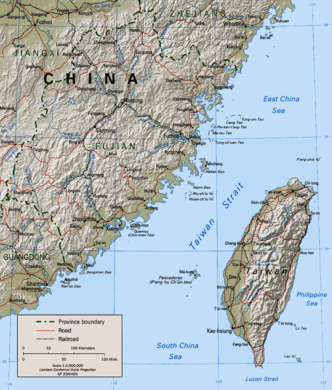
Back Derde Straat van Taiwan-krisis Afrikaans أزمة مضيق تايوان الثالثة Arabic Třetí krize v Tchajwanské úžině Czech Dritte Taiwanstraßenkrise German Tercera crisis del estrecho de Taiwán Spanish Troisième crise du détroit de Taïwan French משבר מצרי טאיוואן השלישי HE Krisis Selat Taiwan Ketiga ID Terza crisi dello stretto di Taiwan Italian 第三次台湾海峡危機 Japanese
| Third Taiwan Strait Crisis 台灣海峽飛彈危機 | |||||||
|---|---|---|---|---|---|---|---|
| Part of the Chinese Civil War | |||||||
 Taiwan Strait | |||||||
| |||||||
| Belligerents | |||||||
|
|
| ||||||
| Commanders and leaders | |||||||
|
|
| ||||||
| Units involved | |||||||
|
|
| ||||||
| Strength | |||||||
|
MIM-104 Patriot, MIM-23 Hawk, F-5 Tiger, F-CK-1, F-104 Starfighter, Knox-class frigate, Oliver Hazard Perry-class frigate, etc. USS Independence (CV-62), USS Nimitz (CVN-68), USS Belleau Wood (LHA-3), USS Bunker Hill (CG-52), etc. |
| ||||||
The Third Taiwan Strait Crisis, also called the 1995–1996 Taiwan Strait Crisis, or the 1996 Taiwan Strait Crisis, was the effect of a series of missile tests conducted by the People's Republic of China (PRC) in the waters surrounding Taiwan, including the Taiwan Strait, from 21 July 1995 to 23 March 1996. The first set of missiles fired in mid-to-late 1995 was allegedly intended to send a strong signal to the Republic of China government under President Lee Teng-hui, who had been seen as "moving its foreign policy away from the One-China policy", as claimed by PRC.[1] The second set of missiles was fired in early 1996, allegedly intending to intimidate the Taiwanese electorate in the run-up to the 1996 presidential election.
- ^ "Taiwan's President Speaks at Cornell Reunion Weekend". Cornell University. Archived from the original on 10 July 2012. Retrieved 20 July 2010.